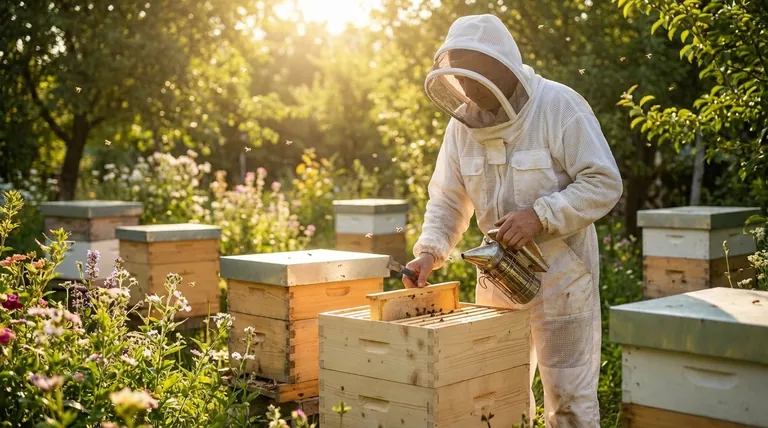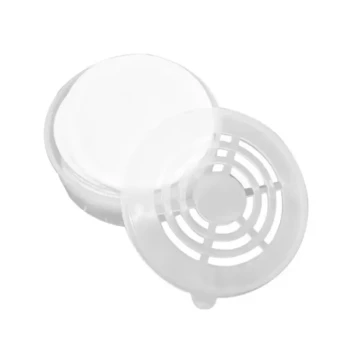At its core, the essential role of a bee suit is to provide a physical barrier between you and the bees, preventing stings. This protection is fundamental to conducting calm, safe, and effective hive inspections, allowing a beekeeper to focus on the health of the colony rather than the threat of being stung.
A bee suit is not just about preventing pain; it's a tool for managing risk and enabling confident interaction with your hives. The right level of protection transforms beekeeping from a potentially stressful activity into a focused and enjoyable one.

The Core Function: A Barrier Against Stings
A beekeeper's primary job is to inspect and manage the hive, which is inherently disruptive to the colony. A quality bee suit mitigates the bees' natural defensive response.
Preventing Physical Harm
The most obvious function of a bee suit is to prevent stings. For most, stings are painful, but for those with allergies, they can be life-threatening. Consistent protection eliminates this immediate physical risk.
Enabling Calm and Confident Beekeeping
When you feel secure, your movements are slower and more deliberate. This calmness is critical, as jerky, panicked movements can agitate bees and trigger a stronger defensive reaction. A suit gives you the peace of mind to work confidently.
Why Protection is Necessary: Understanding Bee Behavior
Bees do not sting out of malice; they sting to defend their colony. Understanding what triggers this response explains why protection is not optional.
The Hive's Defensive Instinct
A honeybee colony is a superorganism that will defend its home, queen, and resources (honey and brood) against perceived threats. When you open a hive, you are a large intruder.
Disrupting the 'Bee Space'
Bees build their hive with precise spacing, often called "bee space" (typically 7-10 mm), which allows them to move freely. When you remove frames for inspection, you break these established pathways, which can cause alarm and trigger defensive behavior.
Understanding the Trade-offs: Full Suit vs. Jacket
The key decision for a beekeeper is not if they need protection, but how much. The two most common options are a full suit or a jacket-and-veil combination.
The Case for a Full Suit
A full suit offers head-to-ankle protection, leaving no gaps for a determined bee to exploit. It is the most secure option and is highly recommended for beginners who are still learning to read a colony's temperament.
Full suits are also the standard for working with highly defensive or unknown hives, where the risk of a coordinated defensive response is higher.
The Case for a Jacket and Veil
Many experienced beekeepers opt for a jacket combined with a veil, paired with thick pants like jeans. This provides less-encumbering protection for the upper body and head, which are the most common targets for stings.
This option offers greater mobility and comfort, especially in hot weather. It is best suited for experienced keepers working with colonies known to have a calm, gentle temperament.
The Non-Negotiable Component: The Veil
Regardless of your choice, the veil is the most critical piece of equipment. It protects your face, eyes, and neck, which are the most vulnerable and dangerous areas to be stung. Never approach a hive without a secure veil.
Choosing the Right Protection for Your Goal
Your choice between a full suit and a jacket depends entirely on your experience level, hive temperament, and personal risk tolerance.
- If your primary focus is maximum safety as a beginner: A ventilated full bee suit is the correct and wisest investment.
- If you are an experienced keeper with known, gentle hives: A high-quality jacket and veil combination often provides sufficient protection and greater comfort.
- If you are involving children or have a bee allergy: Do not compromise; a full suit is the only responsible choice for ensuring complete protection.
Ultimately, proper protective gear empowers you to be a better, more observant, and more effective beekeeper.
Summary Table:
| Protection Level | Key Features | Best For |
|---|---|---|
| Full Bee Suit | Head-to-ankle coverage, maximum security | Beginners, defensive hives, children, allergy sufferers |
| Jacket & Veil | Upper body & head protection, increased mobility | Experienced keepers with gentle, known hives |
| Essential Veil | Protects face, eyes, and neck | All beekeepers; non-negotiable safety component |
Equip yourself for success with HONESTBEE.
Whether you manage a few hives or a large commercial apiary, the right protective gear is the foundation of safe and productive beekeeping. HONESTBEE supplies durable, high-quality bee suits and equipment designed for the demands of serious beekeepers and distributors.
Let us help you protect your passion and your business. Contact our team today to discuss your wholesale needs and discover how our beekeeping supplies can support your operations.
Visual Guide

Related Products
- Wholesales Dadant Size Wooden Bee Hives for Beekeeping
- Yellow Plastic Bucket Pail Perch for Beekeeping
- Professional Insulated Winter Hive Wrap for Beekeeping
- Long Langstroth Style Horizontal Top Bar Hive for Wholesale
- Automatic Honey Flow Beehive 4 Frame Mini Hive for Beekeeping
People Also Ask
- What is the best place to keep bees? Find the Perfect Apiary Site for Your Hives
- What are the characteristics of oil-based paint for beehives? Durability vs. Modern Practicality
- What should beginners consider when purchasing beekeeping equipment? A Guide to Essential Starter Gear
- How often should the area under beehives be inspected and cleaned during the warm season? A Proactive Maintenance Guide
- What should you do if you find an ant nest near your beehive? Essential Strategies for Hive Protection



















